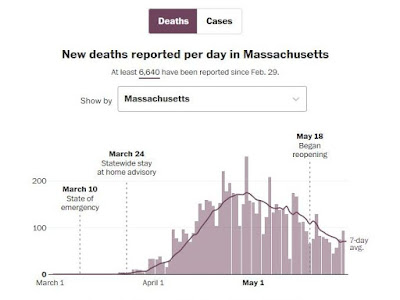The current COVID-19 pandemic is the first pandemic caused by a coronavirus. What is a coronavirus?
(Two earlier posts may be helpful for background.
Past Pandemics is about earlier pandemics caused by influenza viruses and bacteria.
Viruses and Bacteria is about the differences between viruses and bacteria.)
There are many, many different types of viruses. Coronaviruses and influenza viruses are two of these many types.
There are many different coronaviruses and many different influenza viruses. Both coronaviruses and influenza viruses are known to infect birds and mammals. Only a small percentage of viruses infect humans. Seven coronaviruses are known to infect humans.
Viruses consist of genetic material (DNA or RNA) surrounded by proteins. They come in many shapes. Coronaviruses are so named because they are roughly spherical with protruding proteins that resemble the
solar corona. See the electron micrograph at the top of this post. (
source) "Corona" is Latin (and Spanish and Italian) for crown.
Four human coronaviruses are known to cause the common cold. Several different types of viruses cause the common cold: rhinoviruses (30-80%), coronaviruses (about 15%), influenza viruses (10-15%), and other types. (
source)
Viruses that cause the common cold are not a big public health concern. The common cold is contagious and annoying, but rarely fatal. Since the turn of the century, however, scientists have identified three new human coronaviruses that cause death in a significant number of cases. The diseases caused by these three new human coronaviruses have been named:
SARS and MERS did not rise to the level of pandemics, but what scientists learned from those earlier diseases may help us understand the current COVID-19 pandemic.
SARS (
link)
Severe acute respiratory syndrome (SARS) was first reported in 2002 in China. No cases have been reported since 2004. Fewer than 1,000 deaths were reported, mostly in China and southeast Asia, none in the United States.
While SARS was not particularly contagious, it was lethal. The percentage of people diagnosed with the disease who died was 11% – an alarming number. (This is called the
case fatality rate.)
The coronavirus that causes SARS is called SARS-CoV or SARS-CoV-1. See the image below:
MERS (
link)
Middle East respiratory syndrome (MERS) was first reported in 2012 in Saudi Arabia and Jordan. Like SARS, fewer than 1,000 deaths have been reported, mostly in the Arabian Peninsula, none in the United States.
Fewer people were diagnosed with MERS than with SARS, but the case fatality rate was even more alarming – around 35%. This is a deadly disease.
The coronavirus that causes MERS is called MERS-CoV. See the image below:
COVID-19 (
link)
Coronavirus disease 2019 (COVID-19) was first reported in China in 2019. It is not as lethal as SARS or MERS, but it is much more contagious. As I write this, nearly 5 million cases have been reported worldwide, and more than 324,000 deaths. (
source) (We don't yet know the case fatality rate, however. By definition the case fatality rate cannot be computed until the pandemic is over.)
The coronavirus that causes COVID-19 is similar to the coronavirus that caused SARS, and is called SARS-CoV-2. See the image at the top of this post.
Aside: The image at the top of this post (
source) is the same as the image in the post
We are in a war (
source) except that it is colored differently. Both images are colorized for artistic effect. The viral particles don't actually have the different colors shown. The coloring in this post shows the coronas more clearly. Both images were captured and colorized by the National Institute of Allergy and Infectious Diseases (NIAID) at their Rocky Mountain Laboratories (RML) in Hamilton, Montana, in February 2020.
The common cold, SARS, MERS, and COVID-19 are all infectious diseases caused by coronaviruses that attack the respiratory system. What makes SARS, MERS, and COVID-19 more deadly than the common cold is that the common cold generally attacks only the upper respiratory system (nose and throat), while SARS, MERS, and COVID-19 also attack the lower respiratory system (lungs). In some cases they also attack other organs.
SARS, MERS, and COVID-19 are all new in this century. And they are all thought to have this interesting aspect in common: that they all originated in bats, and were transmitted to humans either directly or through another species.
For MERS the intermediary species was the dromedary camel. (MERS is also known as camel flu.) SARS and COVID-19 are thought to have originated in horseshoe bats. The palm civet is considered a possible intermediary species for SARS, and the pangolin may have been an intermediary species for COVID-19. The diseases may also have passed directly from bats to humans.
Cute animal photos at the end of this post!
I'll stop here and leave you with a few references if you are interested in further research:
For information about the seven known human coronaviruses, see webpages by the Centers for Disease Control and Prevention (CDC)
here and
here.
For information about the three recent human coronavirus diseases, see the CDC's webpages for:
SARS,
MERS,
COVID-19.
For a discussion about the role of bats, see this article in the
Wall Street Journal on 4/09/2020:
The Bats Behind the Pandemic. (Very interesting, but probably behind a paywall, sorry.)
For an excellent discussion about SARS, MERS, COVID-19, and coronaviruses in general, listen to this podcast at "This Podcast Will Kill You" posted 2/04/2020:
Episode 43 M-m-m-my Coronaviruses
Transcript
here. See
Podcast Recommendation on my other blog, The Switchel Philosopher, for background about "This Podcast Will Kill You." This episode was my initial introduction to coronaviruses. Recommended.
COVID-19 Statistics Update
There have been more than 324,000 deaths worldwide (
source); approximately 90,000 deaths in the U.S. (
source); and 54 deaths in Vermont (
source). Comparable statistics for earlier dates:
March 26,
April 4,
April 25.
Cute animal photos follow!
Dromedary camel (
source):
Horseshoe bat (
source):
Palm civet (
source):
Pangolin (
source):
































